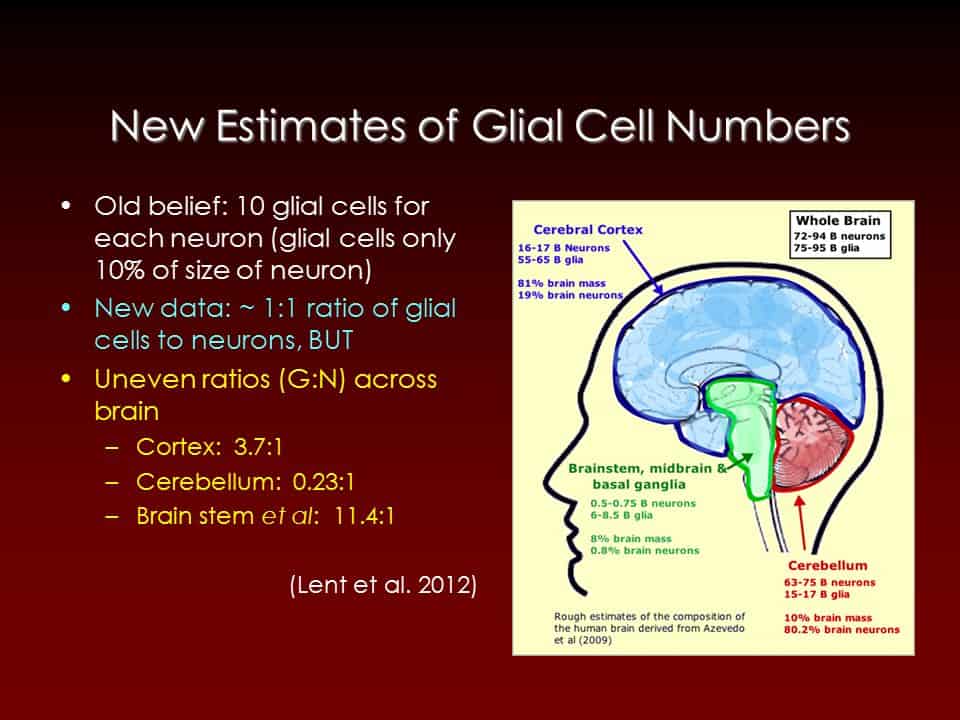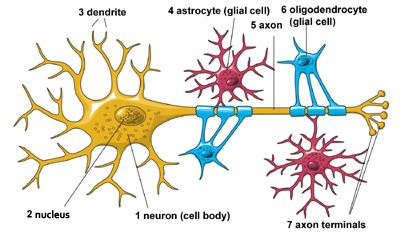In The Other Brain, Douglas Fields, PhD, tries to make the case that glia cells are more crucial to thought than neurons. Unfortunately, his chapter titles and subtitles promise more than they deliver.
Although he did not convince me that the non-neuron cells in the brain are primary to thought; nevertheless, the book teems with interesting facts and possibilities.
Some factoids of interest:
- Most of brain is non-neurons. There are ten times as many glia cells as neurons.
- Voluntary movement is controlled by basal ganglia.
- Acetylcholine—stimulates movement
- Dopamine – inhibits movement
- Hypothalamus—regulates many automatic functions
- Node of Ranvier—repeater in myelin, regenerates the signal to distant receiving synapses

New estimates of relative numbers of glia to neurons in the brain (Lent, 2012) raises the question of why it’s relative low ratio in the cerebellum as compared to the cortex. The answer should bear on the difference between cogitation and automatic reactions.

Glia types in spinal cord and in brain—oligodendrocyte; astrocyte; microglia cells.
- Glia—non-electrical, non-neural action occurring in the brain which Fields ascribes much mental power to, which typically is assigned to neurons.
- 100 times slower actions than neuron communications
- Control myelination (and blood flow to neurons)
The author’s personifies astrocytes and other cells in The Other Brain was irritating and cloying to my ear.
Einstein’s brain had twice as many non-neuronal cells as the average brain (in the 3 slices tested).
Professor Fields writes about thinking, but he questions current neural orientation, rather than demonstrates that the other brain thinks independently. E.g. p.250, ‘Does information pass from the “neuronal brain” into the “other brain,” where it is processed inside glial circuits and then drives neuronal information processing in ways that chains of neurons linked in series using synaptic connections cannot?’
His chapter titles and subtitles promise much more than they deliver.
‘What Is a Thought?’ discusses fMRI. At the most, that’s an image of a thought, not a thought.
p. 306 ‘We now know that the other brain works independently but cooperatively with the neuronal brain.’ The book does not demonstrate the truth of ‘independently’. Previously Field writes on p. 267
‘The unconscious processes in the brain are far more mysterious and inaccessible to research than conscious mental activity. Is this curiosity a coincidence or does it illuminate a more general property of the other brain? I believe it is the latter.’ A statement like this I expect to see in a forward, something to be demonstrated in the book, rather than brought up near the end.
Fields also writes about diseases connected to glia, which is interesting and more convincing than his speculations on ‘The Other Brain’ thinking,
Fields seems quite interested in subconscious thinking (by extent of text devoted to it), by which he means unconscious bodily functions rather than suppressed conscious thoughts. In my opinion, unconscious bodily functions are better termed preconscious thoughts. Those functions appeared before consciousness appeared in distant ancestors of humans (certainly before verbal consciousness was achieved in humans).